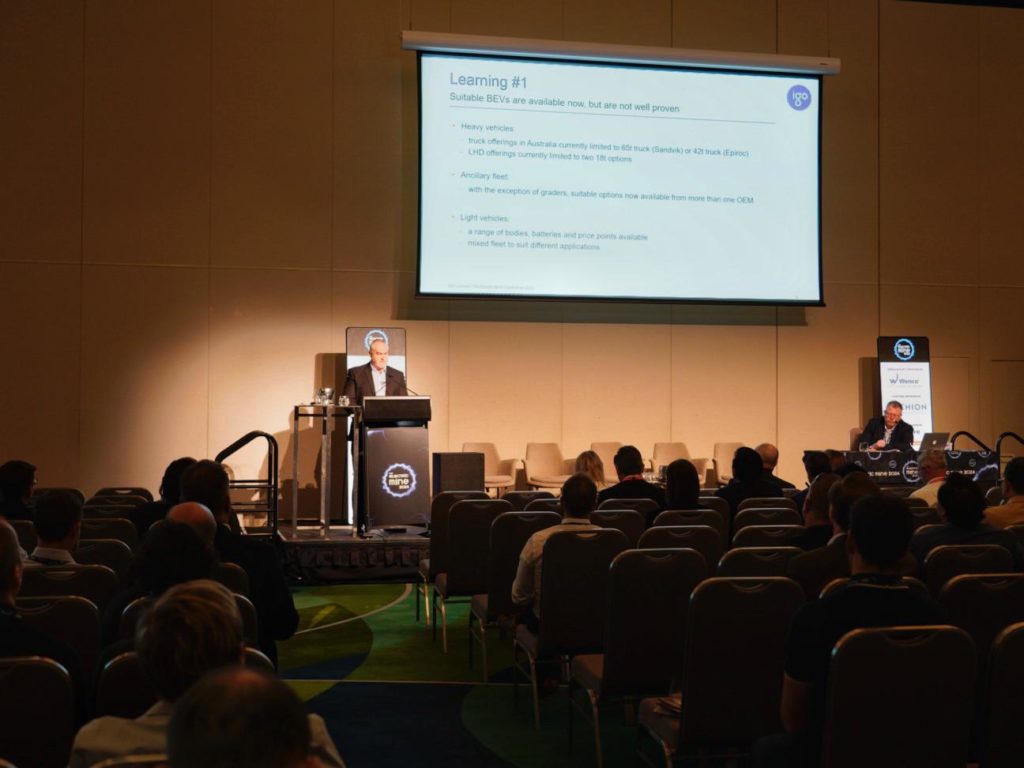A collaboration between IGO Ltd, Perenti and ABB has revealed that an all-electric underground fleet for the Cosmos nickel mine would be competitive with the existing all-diesel operating fleet that was planned. The Cosmos Underground Electrification Study is one of the first pre-feasibility level analyses of the technical and economic aspects of converting an Australian underground mine’s fleet from diesel vehicles to BEVs. The study has been released on Day 1 of The Electric Mine 2024 conference in Perth, where Chris Carr, IGO Acting COO presented a summary of the findings.
The study covered mine design optimisation for electric operations; production and operating philosophy; fleet selection; power distribution and electrical infrastructure design; electrification system and battery management; ESG and safety impact analysis; and modelling of both capital and operating costs. The study assessed the feasibility of electrifying the entire Cosmos underground diesel fleet, including heavy vehicles such as trucks and loaders, ancillary vehicles such as drills and charge rigs, and light vehicles, including 4WD utes for transporting people and equipment.
The Cosmos Project is located 30km north of Leinster in Western Australia

Key study findings were first that based on OEM provided assumptions, BEV fleet offerings matching the productivity of the Cosmos diesel mobile fleet are currently available in the Australian market. The estimated cost to electrify the Cosmos underground fleet was not prohibitive over the envisaged life of mine, even based on conservative productivity and cost assumptions. Thirdly, a Cosmos BEV fleet would enable a significant reduction in cooling and ventilation demands compared to the existing diesel fleet, which offset the additional power required by the proposed BEV fleet. Consequently, the estimated overall power balance of the electrified Cosmos site was on average less than that of the existing diesel operation.
Perenti Group Executive Sponsor for electrification/decarbonisation Raj Ratneser said: “An all-electric mine is closer than ever, with the right equipment available and the mindset of the industry changing. As BEV technology develops, and our understanding of how these vehicles can be best integrated into an operating mine improves, we expect electric mining solutions to only become more competitive against existing diesel powered options.”
ABB Business Line Manager Mining Max Luedtke said: “Mines can become even more energy efficient with vastly reduced levels of CO₂ emissions, while at the same time staying competitive and ensuring high productivity, in part due to the higher tramming speeds of electric loaders and trucks compared to their diesel equivalents. We have been investing in electric mining transport through our eMine portfolio for several years now and have seen the technology go from strength to strength. We expect the outcome of this study to provide more momentum for electrification so our industry can continue to make real progress in lowering its emissions, while improving the health and safety of our people.”
Whilst fully electric fleets are inherently more complex to manage than diesel fleets, the study found that a Cosmos BEV fleet could meet the required levels of productivity through a combination of strategically located battery swapping stations and charging points to minimise downtime. Specifically, the Study concluded that two 65 t BEV trucks could replace and match the haulage capacity of Cosmos’ two planned 63 t diesel trucks. The BEV trucks would utilise battery swapping stations, with swaps occurring every 3-5 haul cycles and taking 8-10 minutes each.
Due to conservative speed assumptions used in the modelling, the planned loading fleet of three diesel loaders may need to be replaced with four BEV loaders, pending more detailed modelling and field trial data to verify real world capability. The BEV loaders would also utilise battery swapping stations, typically requiring a fresh battery 2-3 times per shift.
Ancillary diesel equipment such as graders, drills and light vehicles could be replaced with BEV equivalents. Unlike the trucks and loaders, these units must be plugged in to charge. It is anticipated that unproductive time would be minimised by strategically locating charging stations at common areas to enable opportunistic charging opportunities, for example, during crib time, at shift change, and while loading and unloading consumables.
Typical of pre-feasibility studies, the study identified further areas for investigation, including more detailed modelling and simulation of BEV loading and haulage, power demand, BEV fleet optimisation, and more detailed consideration of the communication network to support an electric Cosmos.
IGO’s Chris Carr said: “IGO is pleased to share this study with the wider industry as it demonstrates that the electrification of underground mining fleet is technically feasible, in the right circumstances. The electrification of fleet at mining operations will be pivotal in the industry’s commitment to advancing towards net zero emissions. In addition, the removal of diesel from underground operations will eliminate diesel particulate matter and other diesel exhaust gases, resulting in improved working conditions and better health outcomes for employees.”
You can access the full version of the study here.











